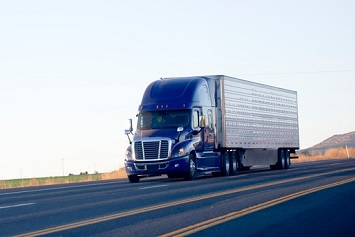Trucking companies that have strong safety cultures and take advantage of advanced safety technology have seen better safety outcomes, a National Surface Transportation Safety Center for Excellence (NSTSCE) study found. There was no single fix for improved safety performance, researchers concluded.

“The results of this study indicate that a comprehensive approach to reducing crashes—which includes deploying advanced technology and building a strong organizational safety culture—can reduce fatalities and injuries on our roadways,” Alex Epstein, National Safety Council (NSC) director of transportation safety said in a statement.
NSTSCE researchers worked with the NSC, insurer Travelers, and state trucking associations and identified nine carriers that experienced significant improvements in safety, including ones once classified as “high risk” by the Federal Motor Carrier Safety Administration (FMCSA). Researchers looked for common factors that contributed to the fleets’ improved safety performance.
Significant Findings
The study found that six out of the nine carriers reported building a strong safety culture that improved safety outcomes. The six carriers that developed strong safety cultures experienced substantial reductions in FMCSA-reportable crashes. The carriers noted that driver and management buy-in to safety programs were important factors in their results. Some also reported getting buy-in from other parts of the carrier’s organization, such as the operations department and dispatch. Other best practices that helped build a strong safety culture included:
- Having zero-tolerance policies for hours-of-service violations;
- Implementing improvements in hiring policies and training protocols and modifying driver scheduling to reduce fatigue;
- Informing drivers about the carrier’s safety culture during orientation and including all employees—not just drivers—in safety training and education; and
- Sharing carrierwide safety indicators with managers and drivers.
Six out of the nine also reported adopting at least one advanced safety technology that significantly improved safety outcomes. One carrier reported a 56 percent decrease in preventable rear-end collisions after equipping its trucks with automatic emergency braking systems.
Some of the other safety technologies the carriers utilized included:
- Blind-spot detection,
- Lane-departure warnings,
- Stability control systems, and
- Video-based onboard safety monitoring systems.
The study’s findings back up previous research that suggests there’s a connection between a carrier’s organizational safety culture and actual safety performance.
None of the carriers that saw significant safety improvements attributed their results to any one change or technology. Instead, all made comprehensive changes ranging from putting new management practices in place and implementing new technologies to improving driver and manager training, hiring guidelines, scheduling, and vehicle maintenance procedures.
“Overall, the carriers attributed their success not to one ‘single fix’ solution but rather the fact that they adopted a comprehensive approach to safety culture and practices within their companies, specifically the adoption of advanced safety technologies,” according to Matthew Camden, research associate with the Virginia Tech Transportation Institute (VTTI) and the study’s principal investigator.
Funding for the study came from the FMCSA, General Motors Corporation, NSC, Travelers, the Virginia Department of Transportation, Virginia Transportation Research Council, and VTTI.

